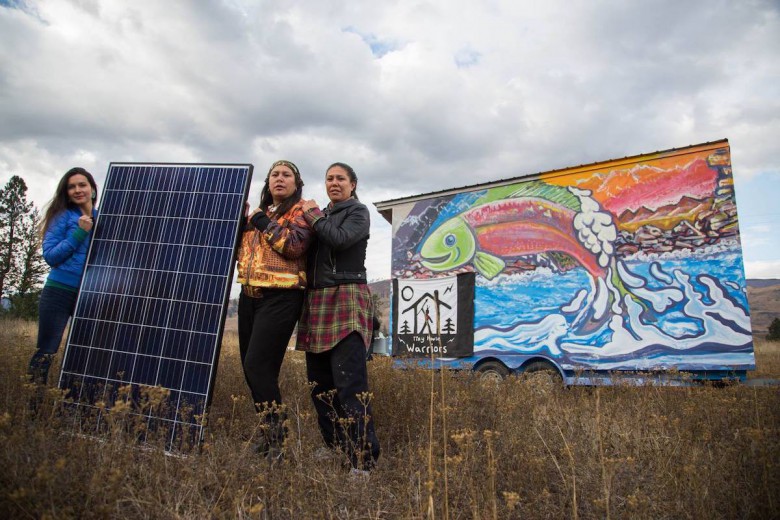In June 2019, the National Inquiry into Missing and Murdered Indigenous Women and Girls (MMIWG) concluded that Canada had committed genocide against Indigenous peoples – one which “especially targets women, girls, and 2SLGBTQQIA people.” Although many Indigenous scholars and activists have been using the word for decades to describe the impacts of historic and ongoing colonization, many Canadians bristled at the word. Genocide is thought to be something that happens in far-away countries, and a lesson we learned not to repeat after the atrocities of the Holocaust. It’s a word that directly challenges Canadians’ notion of their country as a benevolent peacekeeper and multicultural mosaic. Anticipating the backlash, the National Inquiry released a dense 46-page supplementary legal analysis of genocide appended to the report, wherein they argue their position.
It’s a word that directly challenges Canadians’ notion of their country as a benevolent peacekeeper and multicultural mosaic.
This article represents seven key learnings from the MMIWG Legal Analysis of Genocide. Although I am no jurist or scholar of genocide studies I felt it was my responsibility to read and wrestle with this Legal Analysis because I use the term “genocide” – specifically “cultural genocide” – when talking about Canada’s treatment of Indigenous people. While Canada has undoubtedly committed both physical and biological genocide, I always stress cultural genocide because it is ongoing. I often encounter thinkers outside the realm of genocide studies who question and debate my use of “cultural genocide.” Some people think I am implying that Canada is denying us our material culture such as our fringe and feathers. Although Canada has historically criminalized our culture and confiscated our regalia, when I use the term “cultural genocide” I am not talking about Canada’s denial of our material cultural accoutrement. I am talking about culture in a much different and deeper way, as I’ll later explain.
1. On defining genocide
The Legal Analysis begins with a warning that constraining our understanding of genocide to the Holocaust model – “a limited prototype of genocide as time-intensive, mass murder, which is calculated, coordinated within a nation-state, and well-planned by authoritarian leaders espousing ideological worldviews” – allows the collective Canadian consciousness to dismiss Canada’s current form of genocide against Indigenous people.
The term “genocide” was coined by Raphaël Lemkin in his 1944 book Axis Rule in Occupied Europe. In it, Lemkin – a Polish-Jewish lawyer, who suffered through 49 members of his family being killed killed during the Holocaust – uses the extermination of the Jews during World War II as the basis for formulating the concept of genocide. But in both his earlier and later writing, Lemkin takes a more expansive view of genocide. As I have recently learned from Holocaust scholar Dorota Glowacka’s chapter “‘Never Forget’: Intersecting memories of the Holocaust and the settler colonial genocide in Canada,” Lemkin “regarded colonialism, including Hitler’s territorial ambitions, as an integral part of the world history of genocide. In unpublished essays and notes on the history of genocides, Lemkin wrote extensively about the conquest of the Americas.”
In fact, Lemkin argued that the destruction of culture is inseparable from the destruction of people.
With this in mind, Lemkin first defined genocide as the “destruction of the national pattern of the oppressed group” and “the imposition of the national pattern of the oppressor” – a broad definition that included many mechanisms of destruction. He identified three types of genocide: physical genocide, the physical destruction of a group; biological genocide, the destruction of the group’s reproductive capacity; and cultural genocide, the destruction of structures and practices that allow the group to live distinctively as a group. In fact, Lemkin argued that the destruction of culture is inseparable from the destruction of people – meaning cultural genocide is genocide.
2. Canada worked to exclude “cultural genocide” from the UN Genocide Convention
When the UN Convention on the Prevention and Punishment of the Crime of Genocide was approved in 1948, Lemkin’s definition had been narrowed. Article III of the original draft – which codified cultural genocide – was removed. The MMIWG Legal Analysis writes that “Colonial states, including Canada, actively pushed for elements of ‘cultural genocide’ to be excluded from the Convention, knowing that they were, at the very least, perpetrating this type of genocide contemporaneously with the drafting of the Convention.”
Through my education in chemistry, psychology, anthropology and Indigenous studies, I know that it is our cultural knowledges that make us the humans we are. All peoples have cultural knowledge – not just Indigenous people. It is our many and various cultural patterns that both differentiate us from the animal world and distinguish human collectives from one another. For the most part, animals do not have culture; and all that humans are – inclusive of our social, cultural, and political structures – emerges from mythological realities, mores, and teachings our ancestral collectives proved and tested over time and thus gathered, practiced, and retained. The point I am making is the denial of Indigenous culture through the imposition of power – such as denying us our land, waterways, and the economic means needed to survive as distinct cultural and thus political groups – to the point where we are forced to take on the oppressor’s mode of culture, is indeed cultural genocide.
“Colonial states, including Canada, actively pushed for elements of ‘cultural genocide’ to be excluded from the Convention, knowing that they were, at the very least, perpetrating this type of genocide contemporaneously with the drafting of the Convention.”
Today, Article II of the Genocide Convention reads: “In the present Convention, genocide means any of the following acts committed with intent to destroy, in whole or in part, a national, ethnical, racial or religious group, as such: (a) Killing members of the group; (b) Causing serious bodily or mental harm to members of the group; (c) Deliberately inflicting on the group conditions of life calculated to bring about its physical destruction in whole or in part; (d) Imposing measures intended to prevent births within the group; and (e) Forcibly transferring children of the group to another group.”
While this UN definition focuses on physical and biological genocide, cultural genocide is inherent in points (c) and (e). What is more, we also need to keep in mind that it is through cultural mechanisms created by humans that the racist and sexist hatred becomes so deeply instilled within us that we are willing to become complicit in the extermination of a people. It is in this way that cultural genocide is inherent in both physical and biological genocide. Said another way, it is through cultural means that physical and biological genocide unfolds.
3. What Canada’s legislation offers
In reading the Legal Analysis it was interesting for me to learn that Canada’s Crimes Against Humanity and War Crimes Act adds “acts of omissions,” or a failure to act, as a crucial element of genocide. This makes sense to me in that standing around and doing nothing to prevent cultural genocide is no better than an act of genocide. In the work I do I see too many people doing nothing to prevent the cultural genocide I experience today, where other people, such as researchers, journalists, photographers, politicians, lawyers, and judges, gain economically from the cultural genocide. It goes without saying that cultural genocide has spawned its own industry.
This makes sense to me in that standing around and doing nothing to prevent cultural genocide is no better than an act of genocide.
The Legal Analysis notes that Canada’s definition of genocide is then divided into two main legal elements: actus reus (conduct) and mens rea (intent). Actus reus is broken down to two parts: the act of genocide; and the perpetration against a protected group. Mens rea, which literally translates to “guilty mind,” refers to the subjective or mental elements of genocide, and it has two parts as well: a general intent; and a specific intent to destroy a protected group in whole or in part. Key here is that both the act of genocide as well as the intent of genocide must be present for the crime to have occurred. Relearning this took me back to my high school law course, but there is more to learn on this as we think through how nation states commit genocide.
4. Understanding genocide as a “composite act”
In line with the International Law Commission, the Legal Analysis states that genocide in Canada is best understood as a “composite act,” meaning the sum of a series of repeated actions and/or omissions against a protected group, which has spanned decades. The Legal Analysis then argues that Canada’s genocide, as perpetrated as a composite act through its policies, is also attributable to Canada under the rules of customary international law. I, though, am not sure what customary international law means.
The Legal Analysis states that genocide in Canada is best understood as a “composite act,” meaning the sum of a series of repeated actions and/or omissions against a protected group, which has spanned decades.
In her three-point commentary on genocide, Indigenous legal thought leader Pamela Palmater explains how genocide is a violation of customary international law: “it doesn’t have to be written down in a book, it doesn’t have to be written down in a treaty, it doesn’t have to be agreed to by anyone. […] Even without a treaty on genocide, it is still against the law, and a crime, to commit genocide.”
“It’s extremely important to understand that Canada is bound both by customary international law and by this UN convention,” she adds.
I hope I gained this key learning correctly — public learning always comes with risk. I am willing to take this risk.
5. On Canada’s actus reus
The Legal Analysis argues that actus reus exists within colonial policies and practices and includes, but is not limited to: the Indian Act; the Sixties Scoop; residential schools; breaches of human and Indigenous rights; the denial of Indian status and citizenship; the crisis in child welfare; the abuse imposed through state institutions; forced re-locations; chronic underfunding of essential services; coerced sterilizations; and the failure to protect women and girls from death in custody, from exploitation and trafficking, and from known killers. These examples include biological, physical, and cultural genocide, where the latter is imposed through policies and practices.
To this list I will add two more acts of cultural genocide that the Legal Analysis does not mention. First is the land claims and self-government process – what Canada calls the “modern treaty process” – such as the one the Algonquins of Ontario are involved with. In these processes, Indigenous Nations are forced to extinguish their land and resource rights through manipulative and obfuscating euphemisms such as “defining our rights completely” and “the non-assertion model”; as Russell Diabo argues, these processes force Indigenous Nations to live as a fourth level of government under Canada’s provincial and federal laws and policies – not as self-determining Nations, but as Indigenous municipalities. Second is the continued destruction of our sacred places, such as Akikpautik – also known as Creator’s First Sacred Pipe – located just minutes upstream from Canada’s Parliament buildings in the Kitchi Zibi (Ottawa River). For the Anishinaabeg, the Sacred Pipe and associated rituals and ceremonies are the ultimate act of reconciliation. Today, this sacred land and waterway are being further desecrated, instead of being preserved as the late Grandfather William Commanda had hoped. The late Grandfather William Commanda, a respected teacher and spiritual leader, lived in what is called Quebec in the community of Kitigàn-zìbì Anishinàbeg First Nation. He was the teacher of many people.
6. Now to Canada’s mens rea
The Legal Analysis notes that there is some difficulty proving state intent to commit genocide, because the development of jurisprudence has pertained to individual responsibility. Regardless, the Legal Analysis quotes international criminal and human rights law scholar William Schabas, who argues nation states “do not have specific intent. Individuals have specific intent. States have policy. The term specific intent is used to describe the inquiry, but its real subject is State policy” (emphasis mine). Essentially, Schabas has argued bodies such as the International Court of Justice look at state policy to determine a nation state’s intent.
What is important is the overall pattern of cultural genocide inherent in Canada’s policies and practices; through this pattern it becomes clear that Canada’s ultimate goal is to destroy the integrity of Indigenous Nations as distinct entities.
A key learning for me here is that this means Canada’s mens rea (intent) is inherent within Canada’s actus reus (the prohibited conduct). Put another way, what is important is the overall pattern of cultural genocide inherent in Canada’s policies and practices; through this pattern it becomes clear that Canada’s ultimate goal is to destroy the integrity of Indigenous Nations as distinct entities.
In thinking about acts (or acts of omission) of cultural genocide through policy I have often wondered if an actual written policy that explicitly outlines the state’s intent to commit genocide has to exist for the genocidal intent to be proven. I am wondering about whether written evidence of genocidal intent has to exist. In clarifying this for me, the Legal Analysis cites Paola Gaeta who has argued, “Absent direct evidence of the existence of a genocidal policy, it would be necessary only to prove that, because of the overall pattern of violence, the ultimate goal of the policy of the state cannot but be that of destroying the targeted group as such.” That said, as I think about this more I come to think that an act of omission is not likely to be written down in policy.
7. What does it mean to destroy a group “in part”?
Within the UN Genocide Convention, the "destruction of a group" does not mean the complete physical and biological annihilation of the group as a whole, as in the case of the Beothuk people of the island of Newfoundland, who became extinct following European colonization. Destruction of a group “in part” refers to the destruction of the group as a social and cultural unit in such a way that they are unable to reconstitute who they are as a group according to the group’s own socio-cultural political structures. On this matter the Legal Analysis concludes, “Canada has displayed a continuous policy, with shifting expressed motives but an ultimately steady intention, to destroy Indigenous peoples physically, biologically, and as social units, thereby fulfilling the required specific intent element [of genocide].”
On the contrary, individual silos void of the depth of their cultural knowledge, and First Nation Reserve communities that are forced to live under the oppressor’s national pattern are both evidence of cultural genocide.
I think this is a key learning for many people, because some people who think through physical and biological genocide think the existence of brown people with brown eyes who are phenotypically distinct as Indigenous people indicates that genocide in Canada did not happen and that cultural genocide is not presently happening. Other people are under the impression that the existence of First Nation reserve communities acting as social cultural units – either under the Indian Act or under self-government models – means Canada is not guilty of cultural genocide. On the contrary, individual silos void of the depth of their cultural knowledge, and First Nation Reserve communities that are forced to live under the oppressor’s national pattern are both evidence of cultural genocide.
In conclusion
I have always stood firm on Lemkin’s broader definition of genocide, even before I learned that cultural genocide was deliberately removed from the UN Convention on Genocide. My thinking process was not narrowed by what is stated in the UN Convention. I knew better. Laws do not codify all truth; sometimes a void serves to hide truth.
That said, in reading the MMIWG Legal Analysis I have learned that both international and domestic laws, as well as international jurisprudence, recognizes and defines genocide more broadly than mass murder and forced sterilization and includes acts of cultural genocide through laws, policies, and practices, as well as acts of omission.
What is worse, because it is harder to see, cultural genocide can unfold for generations, while we all sit around and argue about its existence.
While, of course, physical and biological genocide was a part of Canada’s colonial genocidal legacy, cultural genocide continues to this day. It has always been my contention that cultural genocide through legislation, policy, and practice is a far more insidious form of genocide because people have a harder time seeing it, placing their finger on it, and thus rallying against it. What is worse, because it is harder to see, cultural genocide can unfold for generations, while we all sit around and argue about its existence.
The National Inquiry, the Truth and Reconciliation Commission, and I are not alone in our position of a Canadian-made cultural genocide. Palmater has argued that Canada’s genocide has relied on, and continues to rely on, several policies of physical, structural, legal, and political erasure. These are all cultural creations and cultural attacks on Indigenous people’s and Indigenous Nations’ ability to live as distinct sovereign Nations. Today, genocide in Canada moves slowly, primarily – though not exclusively – through cultural means, and is thus harder to identify. This is especially true when prime ministers and politicians giigdiyan wezhigeyan (speak with forked tongue), masking it through the use of such terms as “reconciliation” and “nation-to-nation relationship.”







